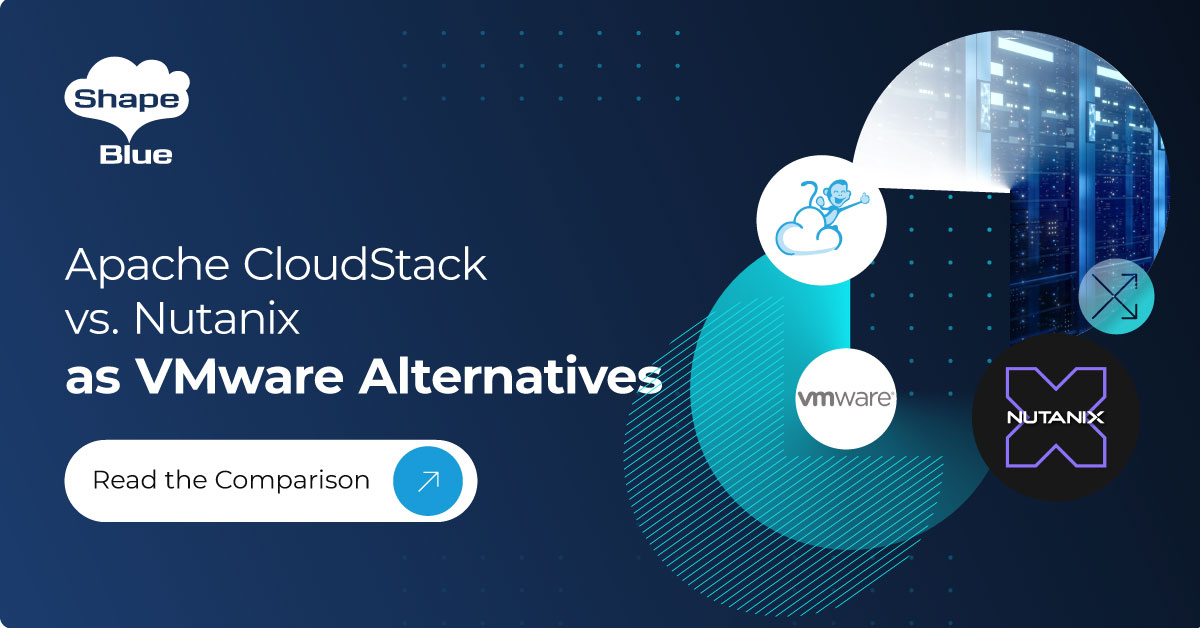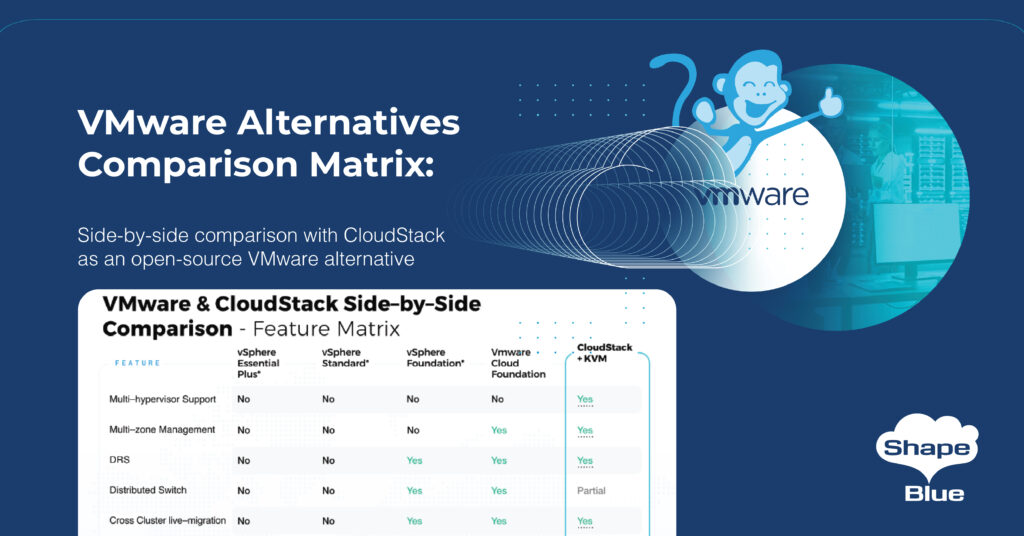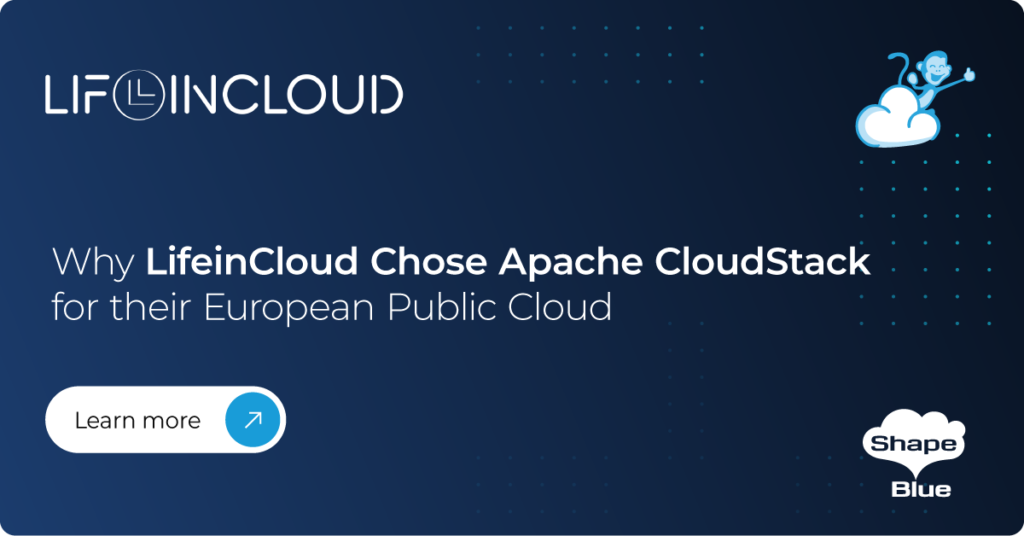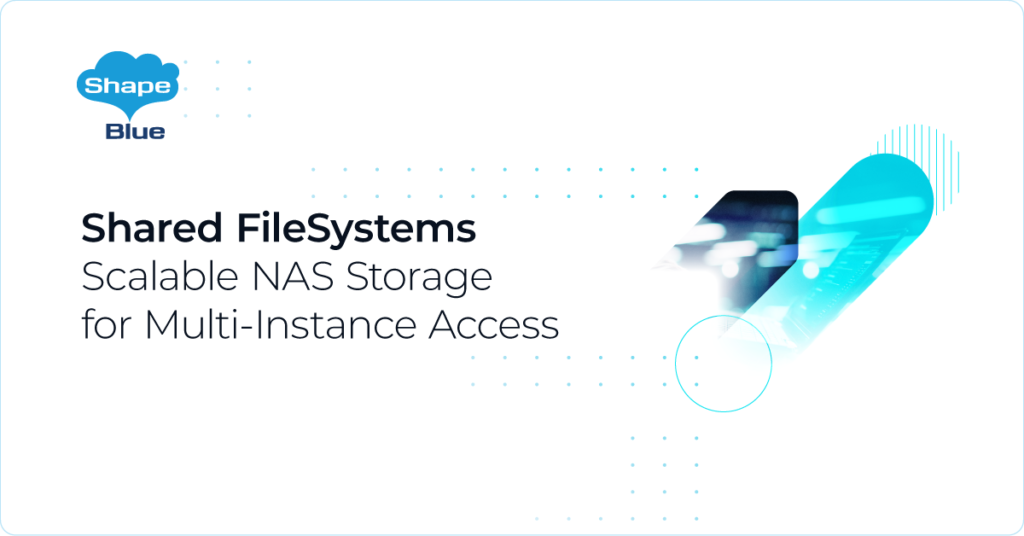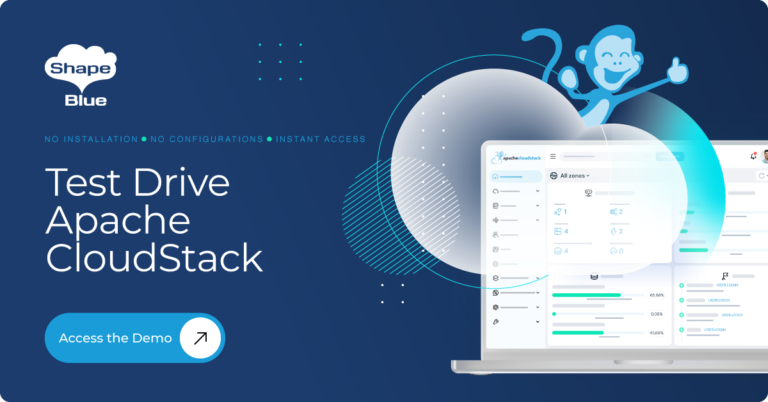The search for VMware alternatives has intensified amidst significant shifts in the virtualisation and enterprise cloud computing market, particularly following VMware’s acquisition by Broadcom. In this article, we will compare Apache CloudStack and Nutanix as VMware alternatives. Nutanix and CloudStack emerge as two leading options for virtualization and cloud management. With VMware’s pricing changes and evolving licensing models, IT teams are exploring solutions that offer flexibility, cost efficiency, and robust performance. In this article, we compare Nutanix vs VMware and CloudStack vs Nutanix, analyzing key factors such as storage, networking, automation, and overall use cases to help you choose the right virtualization platform.
Both technologies share the common goal of simplifying infrastructure management and supporting modern virtualisation technologies, yet they diverge significantly in their implementation and use cases. Apache CloudStack, widely adopted by CSPs, MSPs, Telecom Providers and organisations operating private and hybrid clouds, excels in its flexibility, multi-hypervisor support, and seamless integration with software-defined storage (SDS) solutions. Conversely, Nutanix, primarily focused on private, multi and hybrid clouds, is renowned for its simplicity, high performance, and tightly integrated HCI capabilities underpinned by its proprietary model.
This article examines how Apache CloudStack and Nutanix position themselves as viable VMware alternatives. It explores their similarities and differences across key areas such as virtualisation, automation, network management, and storage, providing organisations with the insights needed to select the solution best suited to their technical and business requirements.
Apache CloudStack as a VMware Alternative
Apache CloudStack is an open-source cloud management platform that simplifies the process of deploying, managing, and configuring cloud environments. Designed to support both public and private clouds, CloudStack is widely recognised for its flexibility and ability to work seamlessly with multiple hypervisors.
CloudStack delivers a comprehensive set of features, including compute orchestration, storage integration, advanced networking capabilities, and native APIs for automation and third-party tool integration. Its architecture is built to handle scalable environments, making it ideal for organisations of all sizes, from small businesses to large enterprises and service providers.
With a strong focus on community-driven development, Apache CloudStack has become a trusted solution for organisations looking for VMware alternative to build reliable, cost-effective, and flexible cloud environments.
Discover a Deep Technical Dive Into the CloudStack Features when Migrating Away from VMware
Nutanix as a VMware Alternative
Nutanix is a provider of hyper-converged infrastructure (HCI) and hybrid cloud solutions, designed to simplify the deployment and management of IT environments. By combining compute, storage, and networking into a unified platform, Nutanix delivers a highly integrated solution that eliminates the complexity of traditional infrastructure silos.
The Nutanix Cloud Platform is built to support private, hybrid, and multi-cloud environments, enabling organisations to manage workloads seamlessly across on-premises and public cloud infrastructures. With its native Acropolis Hypervisor (AHV) and support for third-party hypervisors like VMware and Hyper-V, Nutanix ensures flexibility and choice. Key features include advanced automation, software-defined storage, disaster recovery capabilities, and native support for Kubernetes and containerised workloads.
Nutanix focuses on delivering simplicity, scalability, and performance through its intuitive management tools like Prism Central. With a strong emphasis on reducing operational complexity, Nutanix empowers organisations to modernise their IT environments while maintaining control over costs and improving agility.
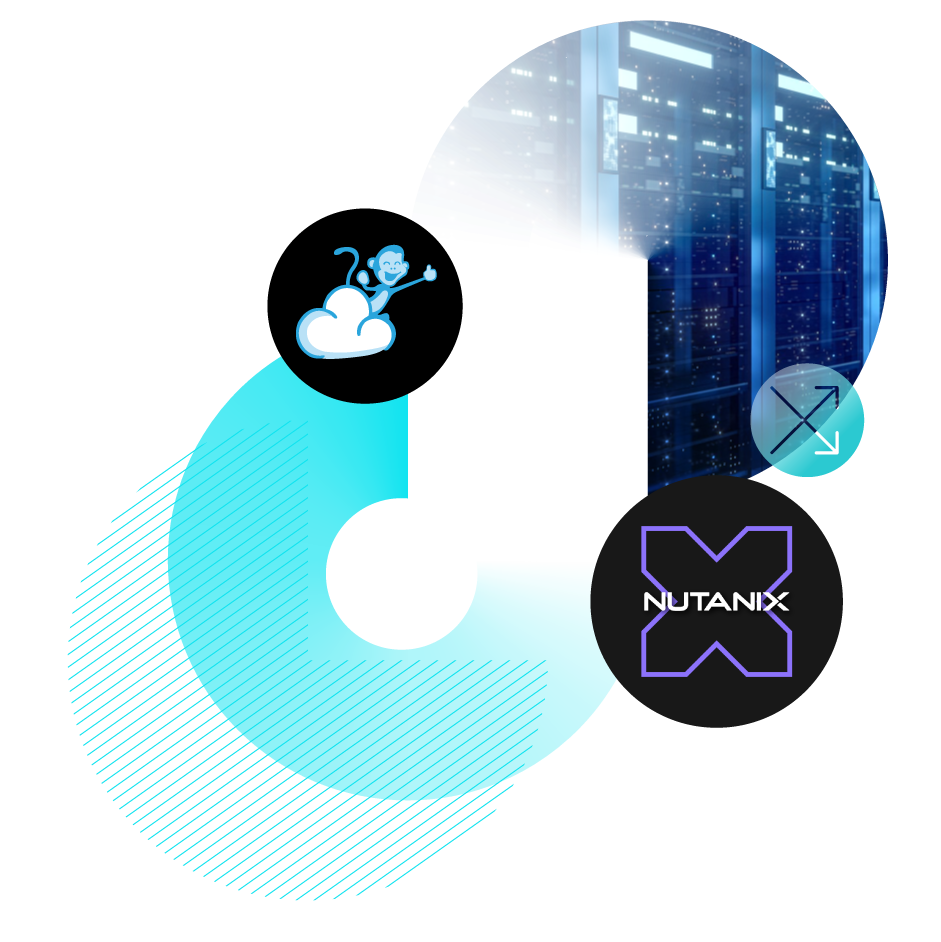 Finding Common Ground: Similarities Between CloudStack and Nutanix as VMware Alternatives
Finding Common Ground: Similarities Between CloudStack and Nutanix as VMware Alternatives
Apache CloudStack and Nutanix, though distinct in their approaches, share several core objectives and capabilities, making them viable alternatives to VMware. Both technologies are designed to:
Simplified Infrastructure Management
- Both solutions aim to reduce complexity in managing IT environments by integrating key functionalities like virtualisation, storage, and networking into a cohesive platform.
- Automation tools in CloudStack and Nutanix help organisations streamline operations, reducing manual overhead.
Support Modern Virtualisation Needs
- CloudStack and Nutanix address the demands of modern IT environments, such as scalability, resilience, and hybrid cloud integration.
- Both platforms provide support for Kubernetes, enabling organisations to manage containerised workloads alongside traditional Virtual Machine Instances.
Enable Hybrid and Private Cloud Deployments
- While Nutanix is primarily focused on private and hybrid cloud environments, CloudStack extends its reach further to public clouds through its adoption by Cloud Service Providers (CSPs).
- Both platforms allow businesses to bridge on-premises infrastructure with public clouds, facilitating workload mobility and hybrid strategies.
Deliver Cost-Efficiency
- Apache CloudStack, as an open-source platform, eliminates licensing fees, making it a cost-effective option for organisations looking to optimise IT budgets.
- Nutanix simplifies IT operations with its integrated HCI approach, reducing the need for multiple tools and minimising operational costs.
Focus on Automation and Orchestration
- Both CloudStack and Nutanix provide tools to automate resource provisioning, lifecycle management, and scaling, aligning with the industry’s shift toward software-defined infrastructure.
- They integrate with third-party tools like Terraform, Ansible, and Kubernetes for enhanced orchestration and automation.
By addressing these shared goals, both Apache CloudStack and Nutanix provide robust options for organisations seeking modern, efficient, and scalable alternatives to VMware. Their overlapping capabilities in infrastructure management, hybrid cloud integration, and automation make them valuable choices for businesses striving to optimise their IT environments. However, their distinct approaches—CloudStack’s open-source flexibility and multi-hypervisor support versus Nutanix’s tightly integrated hyper-converged infrastructure—offer unique value propositions that align with different organisational needs and priorities. Understanding how these technologies deliver on their promises is key to identifying which solution is the right fit for a specific use case or strategic objective.
Key Differences: Apache CloudStack vs. Nutanix – Which is the best VMware alternative?
While Apache CloudStack and Nutanix share common ground in simplifying infrastructure management and supporting modern virtualisation, their approaches, architectures, and target audiences diverge significantly. These differences define their unique value propositions and suitability for specific use cases.
Licencing and Cost Structure when Considering VMware Replacements
Apache CloudStack
CloudStack is fully open-source virtualization platform, offering organisations the freedom to use, modify, and extend the platform without vendor-imposed restrictions. This eliminates the risks associated with vendor lock-in, which became evident during VMware’s acquisition by Broadcom, causing uncertainty for its users. By relying on a robust open-source community and a transparent development process, CloudStack provides a stable and predictable platform. Its cost-effectiveness makes it an attractive option for organisations prioritising flexibility, scalability, and the ability to future-proof their infrastructure against market disruptions.
Nutanix
Nutanix operates under a proprietary, subscription-based licensing model with tiered options (Starter, Pro, Ultimate) offering incremental features. While this model simplifies access to advanced capabilities, it creates a reliance on vendor-controlled updates and support, introducing a significant risk of vendor lock-in, similar to concerns associated with VMware. This dependency can lead to higher long-term costs, especially for organisations looking to scale their infrastructure. For businesses prioritising financial predictability, scalability, and open-source flexibility, Nutanix’s proprietary approach may not fully align with their long-term strategic goals.
Hypervisor Support for Virtualization Management
Apache CloudStack
Apache CloudStack focuses on managing virtualisation environments and extends the existing features of supported hypervisors like KVM, VMware, and XenServer. By adding advanced orchestration, multi-tenancy, and API-driven management, CloudStack enhances the capabilities of the underlying hypervisors. This makes it a strong option for organisations building cloud infrastructure, especially those seeking features such as advanced networking, resource scheduling, and seamless integration with storage and Kubernetes.
Nutanix
Nutanix focuses on its native AHV (Acropolis Hypervisor), which is optimised for simplicity and performance within its ecosystem. While it supports other hypervisors like VMware and Hyper-V, these options often come with additional costs and less seamless integration.
Approach to Storage: A Key Consideration When Evaluating VMware Alternatives Like CloudStack and Nutanix
Apache CloudStack
CloudStack supports industry-standard storage protocols compatible with its underlying hypervisors, providing seamless integration with diverse storage backends. It is also integrated with Software-Defined Storage (SDS) solutions such as Ceph, StorPool, and Linbit, enabling advanced storage features like replication, scaling, and high availability. This flexibility empowers organisations to design cost-effective, scalable storage infrastructures tailored to their specific workloads and operational requirements.
Nutanix
Nutanix’s HCI model is built around a tightly integrated distributed file system that delivers advanced storage features such as deduplication, compression, and tiering. This design ensures simplicity and high performance. However, its proprietary nature can limit customisation and interoperability with third-party storage solutions, potentially constraining organisations seeking more diverse or adaptable storage options.
Networking Capabilities: A Crucial Factor in Choosing CloudStack or Nutanix as a VMware Alternative
Apache CloudStack
CloudStack delivers an extensive array of networking features designed to cater to diverse environments and complex infrastructures. It supports Isolated and VPC networks—both NATed and Static/Dynamic (BGP) Routed—as well as Shared Networks with Security Groups. These capabilities are complemented by Virtual Private Clouds (VPCs), VLANs, VXLANs, network ACLs, firewalls, VPNs (site-to-site and user), Load Balancers, and Private Gateways. For advanced networking scenarios, CloudStack integrates seamlessly with third-party SDN solutions such as Netris, VMware NSX, and OpenSDN (formerly OpenContrail and Tungsten Fabric), enabling features like micro-segmentation for granular traffic control and workload-level isolation.
Additionally, CloudStack supports Virtual Network Functions (VNF), including virtual routers, custom firewalls, and load balancers, empowering organisations to implement flexible and automated solutions tailored to their specific requirements. Its ability to combine traditional network features with SDN-based integrations makes it highly adaptable for multi-tenant environments, hybrid clouds, and edge computing use cases, offering more extensive and customisable networking options compared to Nutanix.
Nutanix
Nutanix provides essential networking capabilities focused on simplicity and streamlined management within its hyper-converged infrastructure (HCI) platform. It supports Virtual Private Clouds (VPCs), Load Balancers, VPNs, BGP, and NAT, while its built-in micro-segmentation feature enhances traffic isolation and east-west security across virtualised environments. Nutanix also includes tools to visualise network dependencies, enabling administrators to identify communication flows and dependencies across workloads with ease.
While Nutanix’s networking functionality is tightly integrated into its HCI platform, enabling seamless coordination with compute and storage resources, it is more constrained in terms of customisation and external integrations compared to CloudStack. This focus on simplicity may appeal to organisations prioritising ease of use over the advanced configurability needed for complex, multi-cloud, or large-scale deployments.
Disaster Recovery Options When Migrating Away from VMware
Apache CloudStack
Apache CloudStack provides disaster recovery (DR) capabilities that can be tailored to meet various organisational needs. Its native features include instance snapshots, volume snapshots, and backup management, which serve as building blocks for DR solutions. For more advanced setups, CloudStack supports snapshot copying across primary and secondary storage, allowing backup and recovery in distributed or multi-zone environments. These capabilities can be further enhanced with third-party integrations, such as Veeam, Dell NetWorker, and Backroll, which extend CloudStack’s functionality to deliver automated failover, backup replication, and recovery workflows.
CloudStack also facilitates Disaster Recovery-as-a-Service (DRaaS) for Cloud Service Providers (CSPs), enabling the creation of robust multi-zone architectures with data replication across geographic locations. While CloudStack’s disaster recovery capabilities are flexible and extensible, implementing advanced setups often relies on user configurations or third-party solutions, making it an ideal option for organisations seeking a highly customisable approach to DR.
Nutanix
Nutanix offers integrated disaster recovery (DR) features that are seamlessly embedded into its platform, providing a streamlined experience for organisations. Nutanix Mine delivers native backup and recovery capabilities, while its Nutanix Data Protection solution includes features such as snapshot-based replication, automated failover, and failback workflows. These features ensure minimal downtime and data loss during disruptions.
Additionally, Nutanix supports disaster recovery in hybrid cloud environments, enabling replication across on-premises and cloud infrastructures. With its integrated management tools, such as Prism Central, Nutanix simplifies the deployment and monitoring of DR policies, offering ease of use and consistency for enterprise environments. While its tightly integrated nature delivers simplicity and performance, Nutanix’s proprietary approach may limit flexibility for organisations that require extensive third-party tool integrations or non-standard configurations.
Evaluating CloudStack and Nutanix as VMware Alternatives: The Role of Automation and Orchestration
Apache CloudStack
Apache CloudStack offers powerful orchestration capabilities, focusing on API-driven management for seamless integration with tools like Terraform, OpenTofu, Ansible and SaltStack. Its automation features simplify the provisioning of compute, storage, and networking resources while supporting advanced workflows such as autoscaling and disaster recovery. CloudStack’s extensive API support makes it a flexible choice for businesses seeking to integrate orchestration into existing IT workflows.
Nutanix
Nutanix simplifies orchestration through Prism Central, its centralised management platform that offers built-in automation for resource provisioning, scaling, and lifecycle management. Prism Central integrates with third-party tools like Terraform, OpenTofu and Ansible to extend its capabilities. With Nutanix Calm, an application-centric orchestration service, organisations can streamline multi-cloud and hybrid cloud deployments, enabling consistent workflows and rapid application delivery.
Hardware Flexibility and Eliminating Vendor Lock-In
Apache CloudStack
CloudStack offers unparalleled flexibility in hardware selection. As a hypervisor-agnostic platform, it supports any hardware that is compatible with the underlying hypervisor, such as VMware vSphere, KVM, XenServer, and XCP-ng. This allows organisations to leverage existing hardware investments or select from a wide range of vendors, ensuring cost optimisation and adaptability. Additionally, CloudStack does not impose any restrictions on hardware vendors or configurations, enabling businesses to customise their infrastructure based on workload requirements or budget constraints. This open approach allows organisations to design cloud environments without being locked into a specific hardware ecosystem.
Nutanix
Nutanix adopts a more controlled approach to hardware flexibility. While it supports deployment on its own Nutanix NX appliances, it also partners with major OEM vendors such as Dell EMC, Lenovo, and HPE, offering certified hardware solutions that are tightly integrated with its software stack. Although Nutanix does allow the use of third-party hardware through its “Bring Your Own Hardware” (BYOH) model, the hardware must meet specific criteria and be listed on Nutanix’s Hardware Compatibility List (HCL). This ensures optimised performance and reliable support but limits the choices for organisations looking for unrestricted hardware options. This certification-driven model may increase costs and limit the ability to reuse existing hardware, making it less attractive for businesses prioritising flexibility and cost control.
Test Drive Apache CloudStack
Experience first-hand how Apache CloudStack can streamline cloud operations and support the creation of customizable, multi-tenant infrastructure as a service (IaaS) environments.
Exploring Use Case Scenarios When Evaluating CloudStack and Nutanix as VMware Alternatives
 Apache CloudStack
Apache CloudStack
Apache CloudStack is a versatile platform that excels in a wide range of use cases across various industries and business sizes. Its flexibility, multi-hypervisor support, and seamless integration with industry-standard storage and networking solutions make it particularly appealing for organisations seeking scalable, customisable, and cost-effective solutions.
When to Choose CloudStack as a VMware Alternative
- Cloud Service Providers (CSPs): CloudStack’s advanced multi-tenancy, API-driven orchestration, and integration with software-defined networking (SDN) solutions make it ideal for CSPs looking to deliver Infrastructure-as-a-Service (IaaS) solutions to their clients.
- Managed Service Providers (MSPs): CloudStack’s robust networking features, such as Virtual Private Cloud (VPC) configurations, Security Groups, and isolated networks, enable MSPs to efficiently manage and secure client workloads.
- Private Cloud Deployments: Organisations needing private cloud environments benefit from CloudStack’s multi-hypervisor support (e.g., VMware, KVM, XenServer, XCP-ng) and compatibility with a wide range of storage backends. It provides the scalability and advanced features required for enterprise-grade workloads.
- Telecom Providers: Telecom providers rely on Apache CloudStack to manage large-scale, geographically distributed infrastructures with advanced networking and scalability needs. CloudStack’s robust multi-tenancy ensures resource isolation, supporting Network Functions Virtualisation (NFV) and customer environments. Its Edge Zones feature enables low-latency services and 5G deployments by extending cloud capabilities to edge locations.
- Hybrid Cloud Environments: CloudStack integrates natively with Kubernetes via Cluster API Project and supports workload distribution across hybrid environments. Its ability to connect on-premises infrastructure with public clouds like AWS and Azure makes it an excellent choice for organisations adopting hybrid strategies.
- High-Performance Workloads: Its support for GPU-accelerated Instances and advanced networking capabilities makes CloudStack suitable for AI/ML workloads, video rendering, and other high-performance applications.
- Kubernetes and Container Workloads: With CloudStack Kubernetes Service (CKS) and Cluster API, organisations can deploy and manage Kubernetes clusters directly within their CloudStack environments. This enables seamless orchestration of containerised applications alongside virtual machine Instance workloads, making CloudStack an attractive option for businesses embracing containerisation and microservices architectures.
- Edge Computing: With the Edge Zones feature, Apache CloudStack enables organisations to extend cloud capabilities to distributed and remote locations. This feature is particularly beneficial for IoT deployments, content delivery, and latency-sensitive applications. By managing resources in Edge Zones with the same CloudStack UI, organisations can streamline their operations across both centralised and edge infrastructures.
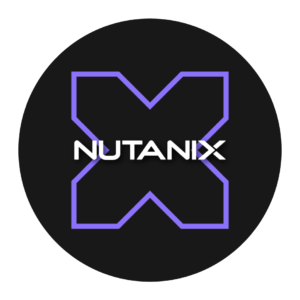 Nutanix
Nutanix
Nutanix is renowned for its tightly integrated hyper-converged infrastructure (HCI) solution, delivering simplicity, performance, and reliability. By combining compute, storage, and networking into a single platform, Nutanix provides streamlined management and consistent performance, making it a strong choice for enterprise environments.
When to Choose Nutanix as a VMware Alternative
- Enterprise IT Environments: Nutanix is best suited for enterprises prioritising ease of deployment, high performance, and unified management. Its tightly integrated HCI model simplifies infrastructure complexity and accelerates time-to-value for IT projects.
- Large-scale Private and Hybrid Cloud Deployments: Nutanix’s software integrates seamlessly with public clouds like AWS, Azure, and Google Cloud, enabling efficient workload migration and hybrid cloud operations. Enterprises adopting hybrid cloud strategies benefit from Nutanix’s ability to manage workloads across environments consistently.
- Virtual Desktop Infrastructure (VDI): Nutanix’s optimised support for VDI workloads makes it a popular choice for organisations deploying large-scale desktop virtualisation environments. Its high performance and simplified management ensure a seamless end-user experience.
- Mission-Critical Workloads: Nutanix’s advanced data services, such as deduplication, compression, and tiering, ensure optimal performance and resilience for mission-critical applications, such as databases, ERP systems, and financial services.
- Edge Computing: Nutanix’s compact and efficient architecture is ideal for edge deployments, offering consistent performance and simplified management for remote or distributed environments.
- Kubernetes and Container Workloads: With Nutanix Kubernetes Engine (NKE), organisations can deploy and manage containerised applications easily, making it suitable for modern microservices-based architectures.
Discover a Detailed VMware Alternatives Comparison Matrix
Weighing the Pros and Cons of CloudStack and Nutanix as VMware Alternatives
Apache CloudStack vs. VMware
Pros
- Open-Source Flexibility: Being fully open-source under the Apache 2.0 license, CloudStack allows organisations to use, modify, and customise the platform without vendor lock-in, providing unmatched flexibility and cost-effectiveness.
- Multi-Hypervisor Support: Supports multiple hypervisors, including KVM, VMware, XenServer, and XCP-ng, enabling diverse infrastructure configurations and hybrid cloud strategies.
- Scalable and Cost-Effective Storage: Integrates with industry-standard storage protocols and Software-Defined Storage (SDS) solutions like Ceph, StorPool, and Linbit, enabling advanced storage features such as replication and scaling.
- Advanced Networking: Offers comprehensive networking features, including SDN, VPC, VLANs, VXLANs, Security Groups, Load Balancers, and Edge Zones for edge computing.
- Container and Kubernetes Support: Native support for Kubernetes via CloudStack Kubernetes Service (CKS) and integration with Cluster API allows seamless management of containerised workloads.
- Broad Use Case Applicability: Widely adopted by CSPs, MSPs, and enterprises for public, private, hybrid, and edge cloud deployments.
Cons
- Complexity for Smaller Teams: While flexible, CloudStack may require skilled administrators to manage and customise effectively, potentially increasing operational complexity for smaller teams.
- Learning Curve: New users may face a steeper learning curve, especially when implementing advanced features like SDN or integrating with third-party tools.
While a fully open-source solution, if you find the learning curve steep, you can always engage with ShapeBlue to get the vendor wrapper and professional support around Apache CloudStack.
Nutanix vs. VMware
Pros
- Simplicity and Performance: Nutanix’s tightly integrated hyper-converged infrastructure (HCI) delivers high performance with minimal complexity, making it ideal for enterprises prioritising streamlined operations.
- Unified Management: Prism Central provides an intuitive management interface, simplifying operations across private and hybrid cloud environments.
- Advanced Data Services: Features such as deduplication, compression, and tiering ensure optimal performance and efficient resource utilisation.
- Strong Hybrid Cloud Integration: Seamlessly integrates with public cloud providers like AWS, Azure, and Google Cloud, enabling hybrid cloud strategies.
- Edge Computing and VDI: Compact architecture and robust support for Virtual Desktop Infrastructure (VDI) workloads make it suitable for edge deployments and distributed environments.
- Kubernetes Support: Nutanix Kubernetes Engine (NKE) provides efficient container orchestration for modern microservices-based applications.
Cons
- Proprietary Licensing Model: Operates on a subscription-based model with tiered licensing (Starter, Pro, Ultimate), leading to potential vendor lock-in and higher long-term costs.
- Hardware Dependence: Requires certified hardware listed on Nutanix’s Hardware Compatibility List (HCL), limiting flexibility in reusing existing hardware or adopting non-certified solutions.
- Less Flexible Networking: Networking capabilities, while sufficient for many workloads, are less comprehensive and customisable compared to CloudStack’s advanced networking features.
- High Initial Costs: Nutanix can pose a significant financial challenge for smaller organisations or those prioritising predictable budgeting and balanced upfront investments. When compared to other solutions, Nutanix’s total costs—including software, potential hardware, and subscription fees—are often higher, which can deter businesses focused on cost efficiency.
- Vendor Dependency: Reliance on Nutanix for updates, support, and feature enhancements creates a risk of vendor lock-in, echoing concerns similar to VMware.
When CloudStack Does Not Fit
Apache CloudStack, while highly flexible and robust, is not a one-size-fits-all solution. Its key limitations include:
- Complex Setup for Small Deployments: For small organisations or environments with minimal virtualisation needs, the deployment and management of CloudStack may appear overly complex compared to simpler, more lightweight solutions like Proxmox or VMware Essentials.
- Limited Vendor-Specific Ecosystem: Organisations that heavily rely on a specific vendor ecosystem, such as VMware or Microsoft Hyper-V, may find CloudStack’s broad compatibility less appealing due to limited proprietary integrations with those ecosystems.
Why Nutanix Does Not Fit All Use Cases
Nutanix is good in simplifying IT management through its hyper-converged infrastructure, but it may not be the best fit for every scenario because of the following:
- High Costs: The upfront and ongoing costs of Nutanix’s proprietary software and hardware requirements can be prohibitive for smaller organisations or those operating on tight budgets.
- Limited Flexibility: Organisations requiring extensive customisation or interoperability with third-party solutions may find Nutanix’s tightly integrated ecosystem restrictive compared to open-source alternatives like CloudStack.
- Vendor Lock-In Concerns: Nutanix’s proprietary model ties businesses to its software stack, limiting freedom in switching to other platforms or leveraging existing investments in diverse hardware and software stacks.
Are Nutanix and CloudStack Good VMware Alternatives?
Apache CloudStack and Nutanix represent two distinct VMware alternatives for companies evaluating different virtualisation management solutions. Both platforms excel in simplifying infrastructure management, supporting modern virtualisation needs, and enabling hybrid cloud deployments. However, their differing approaches, licensing models, and target use cases define their unique strengths and limitations.
CloudStack’s open-source foundation, multi-hypervisor support, and cost-effectiveness make it an ideal choice for organisations prioritising flexibility, scalability, and broad hardware compatibility. Its robust networking and Kubernetes integration further enhance its appeal for cloud service providers, managed service providers, and enterprises embracing hybrid or edge computing strategies.
Ultimately, the decision between Apache CloudStack and Nutanix as alternatives to VMware should be guided by the organisation’s technical requirements, operational priorities, and long-term strategic goals. While CloudStack provides unmatched flexibility and scalability for diverse workloads, Nutanix’s integrated simplicity caters to businesses seeking an all-in-one, high-performance solution. Both platforms offer unique opportunities to optimise IT environments, and the right choice will depend on balancing these strengths against specific business needs and constraints.
Marco Sinhoreli is a seasoned Technical Marketing Manager at ShapeBlue, with over 25 years of IT experience. As an Apache CloudStack expert and committer, he specializes in creating and delivering technical marketing content that bridges the gap between technology and business. Marco has consulted major companies on implementing IaaS solutions with CloudStack, focusing on delivering cloud infrastructure that supports both immediate and long-term business needs. When he’s not diving into cloud solutions, Marco loves playing guitar, exploring new places, and staying updated on politics.
